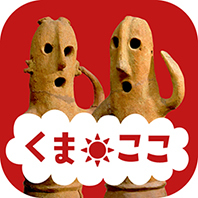令和3年度「地域観光資源の多言語解説整備支援事業」ー妻沼聖天山歓喜院 紵絲斗帳ー [その他]
Choshitocho Cloth
紵絲斗帳
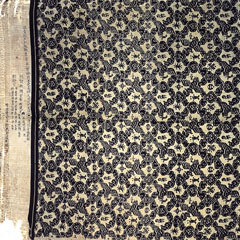
One of the treasures of Menuma Shodenzan Temple is a length of ramie textile woven with mandarin ducks and clouds in red thread on a dark blue background. It was made in China during the Jiajing era (1522–1566) of the Ming Dynasty (1368–1644). The cloth measures 147 x 170 centimeters and includes a border inscribed with the fabric’s provenance.
The cloth is believed to have been dedicated to the temple by Narita Nagayasu (1495–1574). The Narita family were based in the Kumagaya area and were patrons of the temple, helping to finance reconstruction work on the main hall in 1552.
The cloth is a Designated Cultural Property of Saitama Prefecture and is on display at the Saitama Prefectural Museum of History and Folklore, in Omiya, Saitama Prefecture.
※この英語解説文は観光庁の地域観光資源の多言語解説整備支援事業で作成しました。

One of the treasures of Menuma Shodenzan Temple is a length of ramie textile woven with mandarin ducks and clouds in red thread on a dark blue background. It was made in China during the Jiajing era (1522–1566) of the Ming Dynasty (1368–1644). The cloth measures 147 x 170 centimeters and includes a border inscribed with the fabric’s provenance.
The cloth is believed to have been dedicated to the temple by Narita Nagayasu (1495–1574). The Narita family were based in the Kumagaya area and were patrons of the temple, helping to finance reconstruction work on the main hall in 1552.
The cloth is a Designated Cultural Property of Saitama Prefecture and is on display at the Saitama Prefectural Museum of History and Folklore, in Omiya, Saitama Prefecture.
※この英語解説文は観光庁の地域観光資源の多言語解説整備支援事業で作成しました。
令和3年度「地域観光資源の多言語解説整備支援事業」ー妻沼聖天山歓喜院 錫杖ー [その他]
Mishotai Shakujoto Staff Finial
錫杖
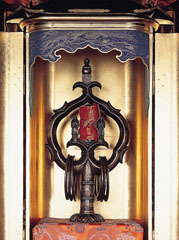
A cast metal finial for a Buddhist staff or shakujo (khakkhara in Sanskrit) is enshrined at the temple. The finial is a loop of metal, with a figure of Shoden (Kangiten) at its center. Shoden, the Buddhist representation of the Hindu god Ganesha, is depicted as two elephant-headed figures in an embrace. Because of the sacred nature of the image, the finial is kept from public view in the inner sanctuary of the main hall (Shodendo) of Menuma Shodenzan Temple. The finial is displayed only on special occasions such as the anniversary of the temple’s founding.
Metal rings hang from the cast metal finials used to ornament wooden shakujo staffs, and the finials themselves have a sharp tip. Monks sometimes shake the staff, which causes the rings to clatter, as an accompaniment to chanting. In the past, monks carried the staff on pilgrimages where they could shake it to scare away predatory animals or use it as a weapon to protect themselves from attackers.
The Mishotai Shakujoto staff was donated to the temple in 1197 by a nephew and two grandsons of Saito Sanemori (1111–1183), the local governor who founded the temple. They dedicated the finial to commemorate the renovation of the main hall. The Mishotai Shakujoto is a National Important Cultural Property.
※この英語解説文は観光庁の地域観光資源の多言語解説整備支援事業で作成しました。

A cast metal finial for a Buddhist staff or shakujo (khakkhara in Sanskrit) is enshrined at the temple. The finial is a loop of metal, with a figure of Shoden (Kangiten) at its center. Shoden, the Buddhist representation of the Hindu god Ganesha, is depicted as two elephant-headed figures in an embrace. Because of the sacred nature of the image, the finial is kept from public view in the inner sanctuary of the main hall (Shodendo) of Menuma Shodenzan Temple. The finial is displayed only on special occasions such as the anniversary of the temple’s founding.
Metal rings hang from the cast metal finials used to ornament wooden shakujo staffs, and the finials themselves have a sharp tip. Monks sometimes shake the staff, which causes the rings to clatter, as an accompaniment to chanting. In the past, monks carried the staff on pilgrimages where they could shake it to scare away predatory animals or use it as a weapon to protect themselves from attackers.
The Mishotai Shakujoto staff was donated to the temple in 1197 by a nephew and two grandsons of Saito Sanemori (1111–1183), the local governor who founded the temple. They dedicated the finial to commemorate the renovation of the main hall. The Mishotai Shakujoto is a National Important Cultural Property.
※この英語解説文は観光庁の地域観光資源の多言語解説整備支援事業で作成しました。
池上遺跡発掘調査について(道の駅整備事業)その7 [発掘調査]
池上遺跡からは、古墳時代前期の周溝持竪穴建物跡が発見されています。
周溝持竪穴建物とは、周溝持遺構や周溝持建物跡と呼ばれることもあり、建物の周囲に排水溝を掘ったものです。このような遺構は、低湿地遺跡に多く発見され、方形周溝墓の一種と考えられてきましたが、近年の研究で建物跡の可能性が出てきました。今回の池上遺跡では、7棟確認されています。中には、周溝持竪穴建物跡の廃棄後、そのまま方形周溝墓に改築した遺構も確認されました。この方形周溝墓の溝から底部穿孔の壺や形状がわかる土器が出土し、本来方形周溝墓の方台部に供献されていたものと考えられます。
なお、令和4年3月12日(土)の池上遺跡現地見学会では、これも見学してもらう予定となっています。

外周の太い溝は方形周溝墓、内側の部分は周溝持竪穴建物跡
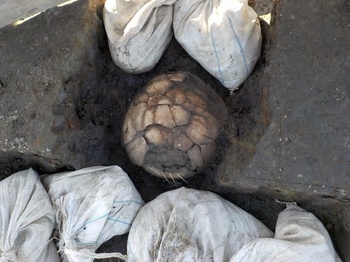
方形周溝墓の溝から出土した底部穿孔の壺
周溝持竪穴建物とは、周溝持遺構や周溝持建物跡と呼ばれることもあり、建物の周囲に排水溝を掘ったものです。このような遺構は、低湿地遺跡に多く発見され、方形周溝墓の一種と考えられてきましたが、近年の研究で建物跡の可能性が出てきました。今回の池上遺跡では、7棟確認されています。中には、周溝持竪穴建物跡の廃棄後、そのまま方形周溝墓に改築した遺構も確認されました。この方形周溝墓の溝から底部穿孔の壺や形状がわかる土器が出土し、本来方形周溝墓の方台部に供献されていたものと考えられます。
なお、令和4年3月12日(土)の池上遺跡現地見学会では、これも見学してもらう予定となっています。

外周の太い溝は方形周溝墓、内側の部分は周溝持竪穴建物跡

方形周溝墓の溝から出土した底部穿孔の壺
令和3年度「地域観光資源の多言語解説整備支援事業」ー妻沼聖天山歓喜院四脚門ー [その他]
Shikyakumon Gate
四脚門
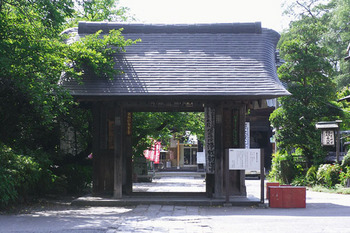
The Shikyakumon Gate is the oldest surviving structure at Menuma Shodenzan Temple. It is believed to have been built in the early Edo period (1603–1867). The gate is supported by four posts (shikyakumon means four-legged gate) and was constructed without nails. It has details typical of the Muromachi period (1392–1573), such as the carved gegyo (decorative wooden pendants) under the gables that act as talismans against fire, and carvings on the ends of the beams. Compared to the larger Kisomon, the Shikyakumon has a simple appearance, and is simply decorated.
White marks halfway up the gate posts indicate the water level during a major flood in 1910, when the nearby Tone River broke its banks and flooded the temple complex and surrounding villages. The gate is also called the chumon (middle gate).
※この英語解説文は観光庁の地域観光資源の多言語解説整備支援事業で作成しました。

The Shikyakumon Gate is the oldest surviving structure at Menuma Shodenzan Temple. It is believed to have been built in the early Edo period (1603–1867). The gate is supported by four posts (shikyakumon means four-legged gate) and was constructed without nails. It has details typical of the Muromachi period (1392–1573), such as the carved gegyo (decorative wooden pendants) under the gables that act as talismans against fire, and carvings on the ends of the beams. Compared to the larger Kisomon, the Shikyakumon has a simple appearance, and is simply decorated.
White marks halfway up the gate posts indicate the water level during a major flood in 1910, when the nearby Tone River broke its banks and flooded the temple complex and surrounding villages. The gate is also called the chumon (middle gate).
※この英語解説文は観光庁の地域観光資源の多言語解説整備支援事業で作成しました。
舟月斎碑 [近世]
妻沼歓喜院境内にある、舟月斎碑を紹介します。
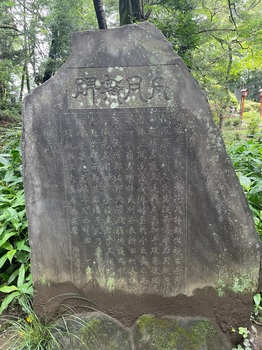 舟月斎碑
舟月斎碑
舟月斎は、市内奈良新田出身の江戸時代後期の修験僧で、挿花の正風遠州流を教え、順任と号していました。
この碑には、舟月斎の事績と造立の契機として、門人達により、舟月斎75歳の長寿の宴が開かれた際、それに招かれた寺門静軒が、碑を建立するにあたり撰文と書を請われ、慶応元年(1865)8月に造立したと刻まれています。
.jpeg) 静軒居士文并書
静軒居士文并書
碑文の終わりには、寺門静軒の漢詩「一生風雅 従事胆瓶 楽以老焉 名与花聲」が刻まれています。読み下すと、「一生風雅 胆瓶に従事し 老いを以って楽しみ 花聲に名を与える」でしょうか。胆瓶(たんぺい)とは首の短い花瓶を指し、風雅を一生の友とし、挿花を楽しんでいた舟月斎のことを詠んだものです。
正風遠州流は、武将で茶人の小堀遠州(1579-1647)を流祖とする華道で、寛政年間に江戸と関東を中心に全国に広がりました。
この碑は、幕末期に、その流派を伝える人物が、奈良新田に存在していたことを示しています。
 舟月斎碑
舟月斎碑舟月斎は、市内奈良新田出身の江戸時代後期の修験僧で、挿花の正風遠州流を教え、順任と号していました。
この碑には、舟月斎の事績と造立の契機として、門人達により、舟月斎75歳の長寿の宴が開かれた際、それに招かれた寺門静軒が、碑を建立するにあたり撰文と書を請われ、慶応元年(1865)8月に造立したと刻まれています。
.jpeg) 静軒居士文并書
静軒居士文并書碑文の終わりには、寺門静軒の漢詩「一生風雅 従事胆瓶 楽以老焉 名与花聲」が刻まれています。読み下すと、「一生風雅 胆瓶に従事し 老いを以って楽しみ 花聲に名を与える」でしょうか。胆瓶(たんぺい)とは首の短い花瓶を指し、風雅を一生の友とし、挿花を楽しんでいた舟月斎のことを詠んだものです。
正風遠州流は、武将で茶人の小堀遠州(1579-1647)を流祖とする華道で、寛政年間に江戸と関東を中心に全国に広がりました。
この碑は、幕末期に、その流派を伝える人物が、奈良新田に存在していたことを示しています。
令和3年度「地域観光資源の多言語解説整備支援事業」ー妻沼聖天山歓喜院貴惣門ー [その他]
Kisomon Gate
貴惣門
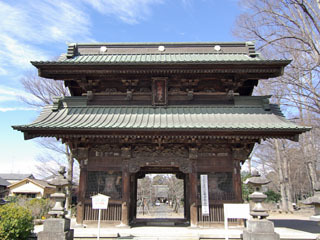
The large and intricately decorated Kisomon Gate is the main entrance to Menuma Shodenzan Temple. It was constructed in 1851 and is the first of three gates that visitors pass through. The wooden gate is over 13 meters tall and supported by eight pillars. The two-tiered roof is distinguished by the unusual feature of three overlapping gables, which protect the carvings beneath from wind and rain.
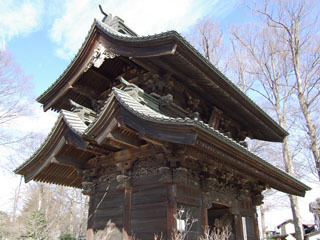
Masterful carvings and ancient stories
Detailed, three-dimensional carvings decorate the eaves and lintels on all sides of the gate. Fearsome dragons—each with a distinctive facial expression—break through waves on the east and west sides, and lions frolic among peonies on the north and south sides. The pairing of lions and peonies was a common motif in art of the Edo period (1603–1867) and is derived from a Buddhist teaching that warns of the dangers coming from inside ourselves. Even the powerful lion is susceptible to tiny parasites, and it was thought that the dew of the peony could protect the lion by killing these parasites, much as the Buddha offers protection.
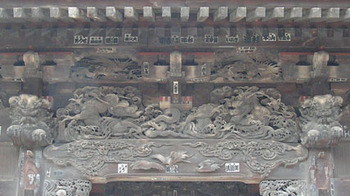
Protecting the temple
On either side of the gate, there is a statue of one of the Four Heavenly Kings, guardians of the cardinal directions. On the left is Jikokuten, lord of the east and guardian of the nation. On the right is Bishamonten, lord of the north and guardian of Buddhist law. Each fearsome figure is depicted stepping on a demon.
A gate built by the community
The wood carvings on the Kisomon Gate are unpainted, reflecting the economic hardship of the country during the final years of the Edo period which led the ruling Tokugawa shogunate to restrict the use of decorative finishes. The gate was built with donations from the local community, and the names of donors are inscribed on small wooden tablets placed among the carvings. It was constructed by a descendant of master carpenter Hayashi Masakiyo (1678–1753), who supervised construction of the ornately decorated main hall around 100 years earlier. The Kisomon is designated an Important Cultural Property.
※この英語解説文は観光庁の地域観光資源の多言語解説整備支援事業で作成しました。

The large and intricately decorated Kisomon Gate is the main entrance to Menuma Shodenzan Temple. It was constructed in 1851 and is the first of three gates that visitors pass through. The wooden gate is over 13 meters tall and supported by eight pillars. The two-tiered roof is distinguished by the unusual feature of three overlapping gables, which protect the carvings beneath from wind and rain.

Masterful carvings and ancient stories
Detailed, three-dimensional carvings decorate the eaves and lintels on all sides of the gate. Fearsome dragons—each with a distinctive facial expression—break through waves on the east and west sides, and lions frolic among peonies on the north and south sides. The pairing of lions and peonies was a common motif in art of the Edo period (1603–1867) and is derived from a Buddhist teaching that warns of the dangers coming from inside ourselves. Even the powerful lion is susceptible to tiny parasites, and it was thought that the dew of the peony could protect the lion by killing these parasites, much as the Buddha offers protection.

Protecting the temple
On either side of the gate, there is a statue of one of the Four Heavenly Kings, guardians of the cardinal directions. On the left is Jikokuten, lord of the east and guardian of the nation. On the right is Bishamonten, lord of the north and guardian of Buddhist law. Each fearsome figure is depicted stepping on a demon.
A gate built by the community
The wood carvings on the Kisomon Gate are unpainted, reflecting the economic hardship of the country during the final years of the Edo period which led the ruling Tokugawa shogunate to restrict the use of decorative finishes. The gate was built with donations from the local community, and the names of donors are inscribed on small wooden tablets placed among the carvings. It was constructed by a descendant of master carpenter Hayashi Masakiyo (1678–1753), who supervised construction of the ornately decorated main hall around 100 years earlier. The Kisomon is designated an Important Cultural Property.
※この英語解説文は観光庁の地域観光資源の多言語解説整備支援事業で作成しました。
令和3年度「地域観光資源の多言語解説整備支援事業」ー妻沼聖天山歓喜院聖天堂ー [その他]
令和3年度「観光庁地域観光資源の多言語解説整備支援事業」にて、妻沼聖天山及び熊谷うちわ祭などに関連した文化財の英語解説文が作成されました。今後、完成した解説文の媒体化に向けて準備を進めていく予定です。
完成した解説文の一部をご紹介します。
Shodendo Main Hall 歓喜院聖天堂
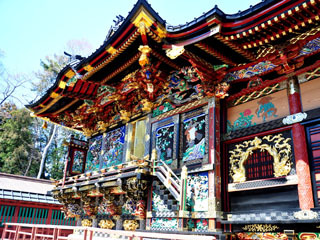
The Shodendo is the main building and the spiritual heart of Menuma Shodenzan Temple. The exterior of the hall is adorned with colorful carvings which depict Buddhist teachings and allegories, aspects of classical Chinese culture, and auspicious animals. These were designed to appeal to lay people. The main hall enshrines Shoden (or Kangiten), the deity of joy, conjugal harmony, and longevity, who is the Buddhist representation of the Hindu god Ganesha. The Shodendo is designated a National Treasure.
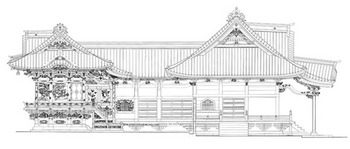
Lavish carvings
The main hall is three halls connected under a single roof: a hall of worship (haiden) at the front, an inner sanctuary (okuden) at the back, and an intermediate hall (chuden) in between. This style of architecture characterized by ornate carvings is known as gongen-zukuri. The style takes its name from Tosho Daigongen, the posthumous name of Tokugawa Ieyasu (1542–1616). He was the founder of the Tokugawa shogunate, which re-united Japan after centuries of civil war, and ruled Japan from 1603 until 1867. His ornate mausoleum at Nikko Toshogu Shrine in Tochigi Prefecture, built in 1635, is one of the most famous examples of gongen-zukuri architecture. The Shodendo is often compared with Nikko Toshogu Shrine for its lavish carvings and architectural style.
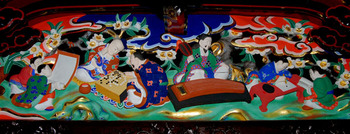
A wealth of color and detail
The roof gables are inset with colorful carvings, and the eaves and lintels are decorated with lions, tigers, and mythical creatures such as dragons. A carved frieze shows figures practicing the four classical accomplishments of ancient Chinese scholars: painting, calligraphy, playing the zither, and the strategy game of go. A similar carving can be found on the Yomeimon Gate at Nikko Toshogu Shrine.
The exterior walls of the inner sanctuary at the back of the main hall are likewise covered in detailed carvings. Layers of vibrant color and gilding enhance the striking appearance of the Shodendo and its carvings.
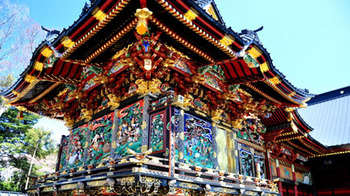
A legacy of craftsmanship
The construction and decoration of the main hall started at the back. As work progressed to the front, the decoration became simpler, likely because of lack of funds. For a small fee, visitors can walk around the back of the main hall to view the carvings more closely.
The Shodendo has been rebuilt several times since Menuma Shodenzan Temple was established in the twelfth century. The current main hall was completed between 1735 and 1760 and was funded entirely by donations from the local community. The cost was around ¥2 billion in today’s money. Master carpenter Hayashi Masakiyo (1678–1753) designed and oversaw the reconstruction with his son Masanobu (1736–1802), who completed the project after his father passed away. They came from a family of master carpenters who worked on prominent shrines and mausoleums during the Edo period (1603–1867), including the restoration of Nikko Toshogu Shrine. The main hall and its carvings were restored from 2003 to 2010.
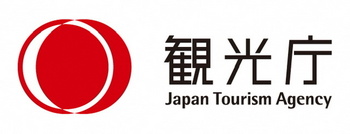
※この英語解説文は観光庁の地域観光資源の多言語解説整備支援事業で作成しました。
完成した解説文の一部をご紹介します。
Shodendo Main Hall 歓喜院聖天堂

The Shodendo is the main building and the spiritual heart of Menuma Shodenzan Temple. The exterior of the hall is adorned with colorful carvings which depict Buddhist teachings and allegories, aspects of classical Chinese culture, and auspicious animals. These were designed to appeal to lay people. The main hall enshrines Shoden (or Kangiten), the deity of joy, conjugal harmony, and longevity, who is the Buddhist representation of the Hindu god Ganesha. The Shodendo is designated a National Treasure.

Lavish carvings
The main hall is three halls connected under a single roof: a hall of worship (haiden) at the front, an inner sanctuary (okuden) at the back, and an intermediate hall (chuden) in between. This style of architecture characterized by ornate carvings is known as gongen-zukuri. The style takes its name from Tosho Daigongen, the posthumous name of Tokugawa Ieyasu (1542–1616). He was the founder of the Tokugawa shogunate, which re-united Japan after centuries of civil war, and ruled Japan from 1603 until 1867. His ornate mausoleum at Nikko Toshogu Shrine in Tochigi Prefecture, built in 1635, is one of the most famous examples of gongen-zukuri architecture. The Shodendo is often compared with Nikko Toshogu Shrine for its lavish carvings and architectural style.

A wealth of color and detail
The roof gables are inset with colorful carvings, and the eaves and lintels are decorated with lions, tigers, and mythical creatures such as dragons. A carved frieze shows figures practicing the four classical accomplishments of ancient Chinese scholars: painting, calligraphy, playing the zither, and the strategy game of go. A similar carving can be found on the Yomeimon Gate at Nikko Toshogu Shrine.
The exterior walls of the inner sanctuary at the back of the main hall are likewise covered in detailed carvings. Layers of vibrant color and gilding enhance the striking appearance of the Shodendo and its carvings.

A legacy of craftsmanship
The construction and decoration of the main hall started at the back. As work progressed to the front, the decoration became simpler, likely because of lack of funds. For a small fee, visitors can walk around the back of the main hall to view the carvings more closely.
The Shodendo has been rebuilt several times since Menuma Shodenzan Temple was established in the twelfth century. The current main hall was completed between 1735 and 1760 and was funded entirely by donations from the local community. The cost was around ¥2 billion in today’s money. Master carpenter Hayashi Masakiyo (1678–1753) designed and oversaw the reconstruction with his son Masanobu (1736–1802), who completed the project after his father passed away. They came from a family of master carpenters who worked on prominent shrines and mausoleums during the Edo period (1603–1867), including the restoration of Nikko Toshogu Shrine. The main hall and its carvings were restored from 2003 to 2010.

※この英語解説文は観光庁の地域観光資源の多言語解説整備支援事業で作成しました。
2022-03-07 14:12
コメント(0)
熊谷の「五家宝」の「100年フード」認定と有識者特別賞の受賞 [お知らせ]

2022年3月3日、文化庁は、地域に根付く食文化を「100年フード」と名付けてPRする新制度で、申請された食や産品など131件を認定したと発表しました。
100年フードは、江戸時代以前から伝わる「伝統」、明治・大正から続く「近代」、昭和以降に生まれ今後100年の継承を目指す「未来」の3部門があり、熊谷市文化遺産保存事業実行委員会が申請した熊谷地域周辺の「五家宝」が伝統の100年フード部門で認定されました。この伝統部門は全国で80件認定され、埼玉県内では他に、草加せんべいが認定されました。近代部門は全国で23件認定され、埼玉県内では行田市のフライ・ゼリーフライが認定されました。他に未来部門が全国で28件認定されました。また、食に関する情報発信に取り組む博物館や道の駅などの「食文化ミュージアム」には70件の選定がありました。
合計131件のうち、「五家宝」は、特筆した価値を有すると評価され、全国で15件の「有識者特別賞」を受賞しました。
同委員会は、五家宝の歴史や概要、伝承技術の現状などの調査研究を進めた上で、100年フードへの申請を行いました。五家宝の100年フード認定と「有識者特別賞」という朗報を受け、今後も熊谷地域の食文化を世界に向けて発信していく所存です。
100年フード公式ホームページ
https://foodculture2021.go.jp/jirei/
池上遺跡発掘調査について(道の駅整備事業)その6 [発掘調査]
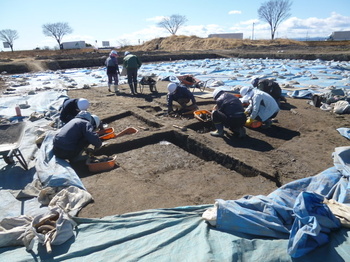
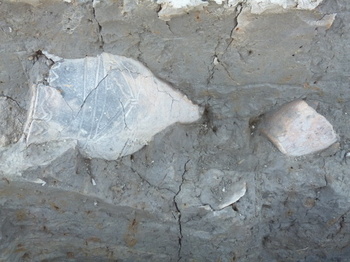
現在、発掘調査が進んでいるE区から弥生時代中期の竪穴建物跡1軒と土坑3基が見つかりました。昨年度から道の駅整備事業に伴い調査を行っていますが、弥生時代の竪穴建物跡を検出したのは令和初となりました。
竪穴建物跡は、まだ調査中のため規模は未確定ですが、6×5m程の楕円形になりそうです。深さは約50㎝と深く、床面の近くから穂摘み具と思われる石器1点や甕形土器などが出土しています。
第55号土坑は、長さ2.6m、幅1.2m、深さ0.6mの楕円形で、ほぼ完形の甕形土器などの遺物が数点出土しています。かなり大きな穴であるためお墓の可能性も考えられますが、今のところ人骨などは見つかっていません。
今回の調査によって弥生時代中期の集落域が遺跡の南東域にも広がりをみせることがわかってきました。
令和4年3月12日(土)に池上遺跡で現地見学会を開催します。
こちらは、事前予約制となっていますので、予約の方は、熊谷市立江南文化財センター(平日午前10時~16時)で電話のみ受付(048-536-5062)しますので、よろしくお願いします。予約は、令和4年3月10日(木)まで受付中です。
源宗寺「平戸の大仏」保存修理プロジェクト第Ⅰ期事業 寄附者名簿の仮納入 [仏像]
令和4年3月3日、市内平戸の源宗寺にて、吉備文化財修復所の牧野先生にお越しいただき、「平戸の大仏」第Ⅰ期保存修理事業寄附者名簿の仮納入を行いました。
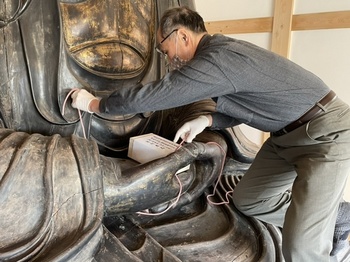
「平戸の大仏」第Ⅰ期保存修理事業では、資金調達のためにクラウドファンディングを実施し、全国各地から、多くの方々にご支援いただきました。支援者の方々への報告と返礼品の発送を今年度中に行うことが決定していることから、クラウドファンディングでご寄附いただいた方々の名簿を先行して仮納入しました。仮納入場所は、薬師如来坐像の両手の上です。
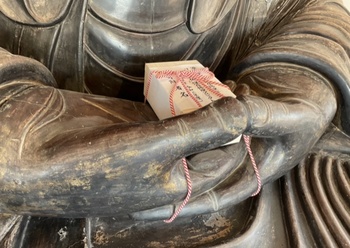
今後、第Ⅱ期の「平戸の大仏」保存修理事業が終了した後に、源宗寺本堂保存修理事業及び「平戸の大仏」第Ⅱ期保存修理事業の寄附者名簿と共に、薬師如来坐像の頭部内に本納入する予定です。

「平戸の大仏」第Ⅰ期保存修理事業では、資金調達のためにクラウドファンディングを実施し、全国各地から、多くの方々にご支援いただきました。支援者の方々への報告と返礼品の発送を今年度中に行うことが決定していることから、クラウドファンディングでご寄附いただいた方々の名簿を先行して仮納入しました。仮納入場所は、薬師如来坐像の両手の上です。

今後、第Ⅱ期の「平戸の大仏」保存修理事業が終了した後に、源宗寺本堂保存修理事業及び「平戸の大仏」第Ⅱ期保存修理事業の寄附者名簿と共に、薬師如来坐像の頭部内に本納入する予定です。
